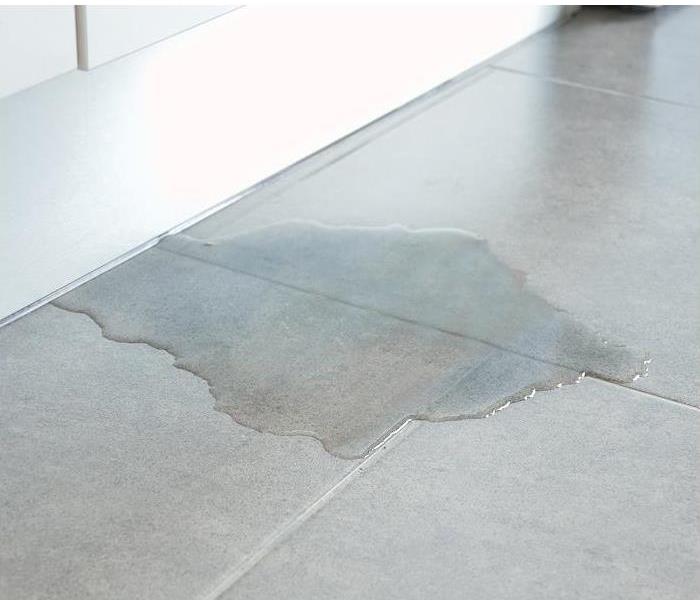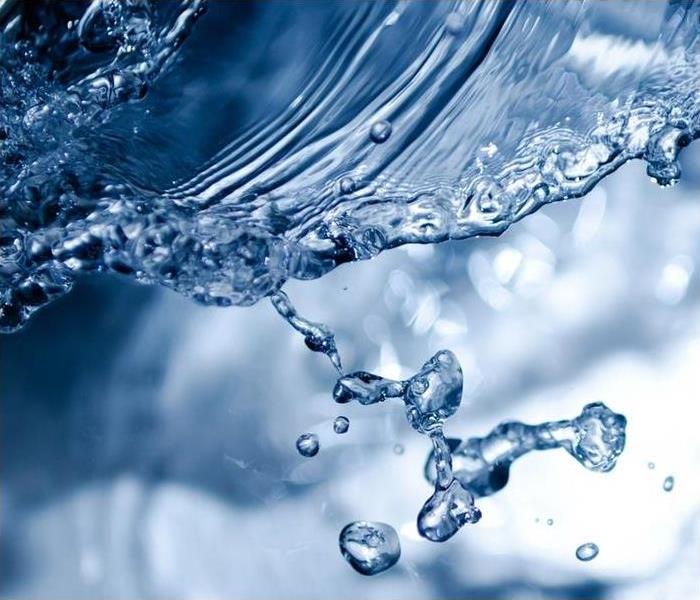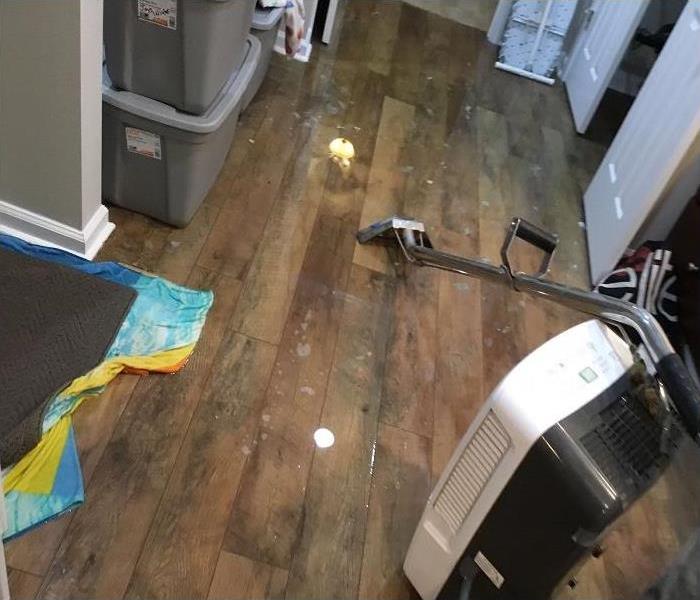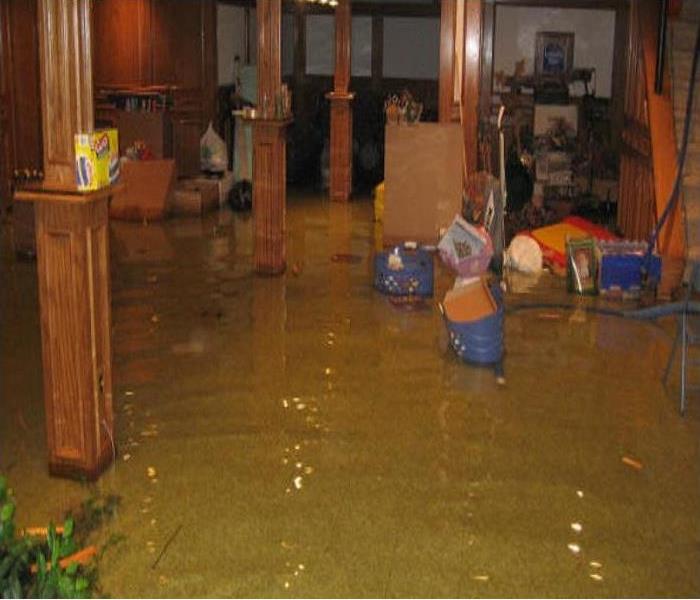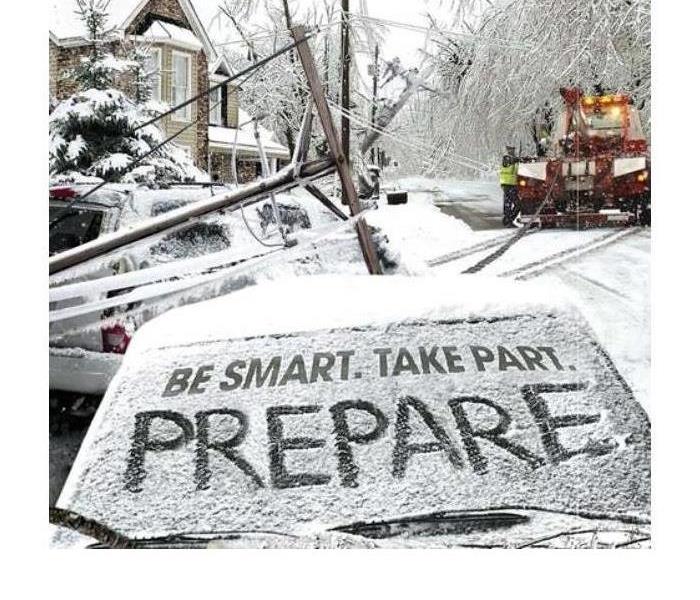Recent Water Damage Posts
Take Steps to Prevent Plumbing Leaks
7/10/2023 (Permalink)
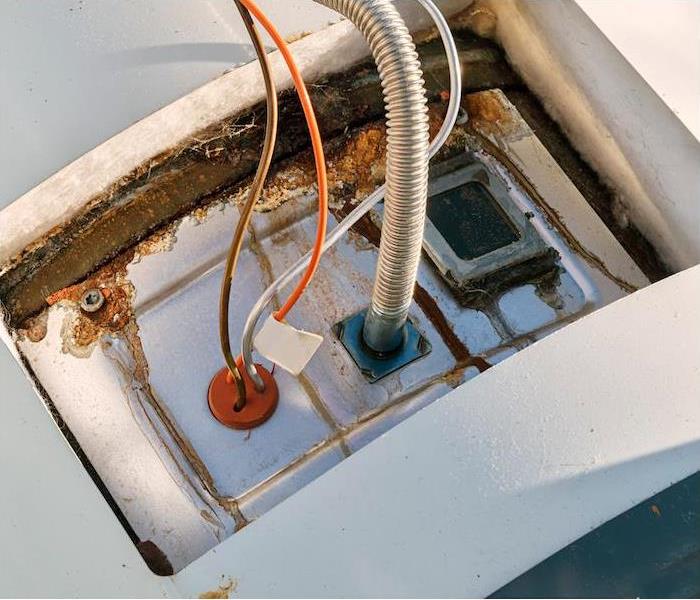 SERVPRO of Gwinnett County South can help at the drop of a hat when you experience any water emergency.
SERVPRO of Gwinnett County South can help at the drop of a hat when you experience any water emergency.
Plumbing leaks are no joke. They can spring up instantly and cause dramatic and costly damage before it can be brought under control.
In fact, the average household in the U.S. experiencing a leak loses 10,000 gallons of water per year—with over 1 trillion gallons nationwide combined yearly! While no one knows whether there is going to be an accident, there are still numerous methods to decrease the chance of a costly plumbing leak in the house.
By maintaining your plumbing, you can lower the risk of a plumbing leak and reduce the damage if one happens. Let’s consider what areas you can regularly inspect and maintain to prevent water damage in the home:
Appliance Water Supply Lines. Every appliance that uses water has water supply lines that are generally made up of plastic or metal tubing. As a result, it is critical to monitor these lines on a regular basis. Keep an eye out for corrosion, discoloration of the pipe itself and the flooring and walls around it, as well as calcium buildup in the supply line. One common modern preventive measure would be to consider upgrading to flexible stainless steel when replacing these lines.
Water Heater. Be sure to follow the maintenance instructions on your water heater carefully. A water heater can burst due to old age and devastatingly flood the room around it in minutes, potentially causing severe and costly damage to your home. A water heater should be inspected by a professional plumber every few years, and if it’s in a location where a leak would be truly devastating, consider installing a leak detector.
Drains. All sinks, disposals, showers, tubs and toilets should be consistently maintained and clean of debris. Make sure that you and other family members are aware of what should and should not be flushed or poured down the kitchen sink. Additionally, if you have a family member that is an over-consumer of toilet paper, consider installing a bidet to prevent build up in your pipes.
Finally, if a leak has sprung out of control, it’s important to know where the main water valve is and how to shut it off. It’s essential that everyone in the home is aware of how to shut the water main line off in the event of an emergency, considering you never know when the emergency can happen.
SERVPRO can help at the drop of a hat when you experience a water damage emergency. Call the experts at SERVPRO of Gwinnett County South. We are available 24⁄7 to respond immediately and get the job done professionally.
Water Damage? We Have You Covered | SERVPRO® of Gwinnett County South
4/20/2022 (Permalink)
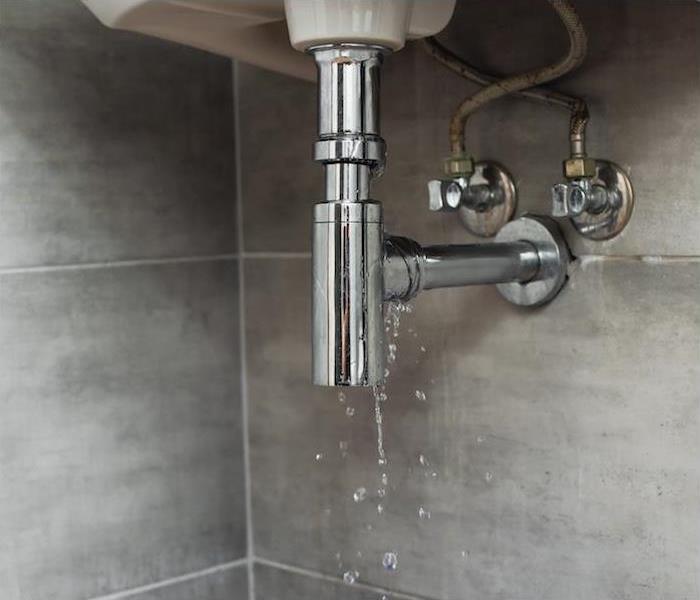 No matter the damage sustained, SERVPRO of Gwinnett County South has the tools and team to help your home return to a normal state quickly.
No matter the damage sustained, SERVPRO of Gwinnett County South has the tools and team to help your home return to a normal state quickly.
A leaking faucet might appear irrelevant now. However, water can have a destructive impact on your home, no matter how small the amount of water. In fact, the typical home leak can waste as much as 10,000 gallons of water in a year.
Water damage proceeds rapidly, seeping right your floors, walls and soft surfaces. That’s why it’s essential to attend to the problem immediately to generate the very best results. Here’s a guide to how water damage progresses.
In the First 24 HoursIf you own a home, there is a one in four chance of a flood impacting your house within a 30-year period in a high-risk area. Recognizing what to do next is essential.
The initial 24 to 48 hours after flooding or water damage is important because some items will instantly succumb to water’s disastrous effects.
Soft furnishings will soak through, and wood structures can swell from the water. Individual valuables like books and pictures are especially vulnerable to ruin. Furthermore, mold and mildew can start to form within this timeframe. Quick activity is crucial.
SERVPRO’s experience, as well as our “restore vs replace” mindset can help you conserve money while preserving precious keepsakes that cannot be replaced. If any items cannot be saved, this will be communicated to you. These materials are removed as soon as possible to expedite the drying and restoration process.
Within the First WeekAfter the first 24 hours, water damage will progress further and quickly. Mold and mildew can spread like wildfire with extreme moisture. As mold sets in, it can even damage your home’s framework.
Additionally, permeable surface areas, such as wood and walls, will become increasingly compromised, and metal surfaces will start to corrode.
After One WeekYou don’t want to allow moisture to rest for a prolonged period since the effects may be devastating or irreparable. As time goes on, the expenses and effort required to restore your home will increase substantially.
How SERVPRO Will AidSERVPRO’s restoration process starts with the very first phone call, preferably within the first 24 hours. The job starts with an extensive extraction of water. This helps avoid the spread of water in your home and also reduces drying time.
Mostly likely, floors, furnishings and other personal belongings will need cleaning, sanitizing and deodorization. After the bulk of the water has been extracted, our experts will use industry-leading drying tools to get rid of the water you can’t see.
After these steps, your house may need reconstruction to get back to its preloss condition. This action could include minor repair work or rebuilding entire sections of your home.
We can streamline the process by dealing with both the preliminary damage mitigation and reconstructing the affected areas. We will keep you up to date on every action and have you back in your home as soon as possible.
Regardless of the type of water damage sustained, SERVPRO has the tools and teams to help your home or business recover. Contact us 24⁄7 when you need a dependable team to help you recover.
24 Hour Emergency Services Offered from SERVPRO of Gwinnett County SE/SW
4/19/2022 (Permalink)
Flooding and water emergencies don’t wait for regular business hours and neither do we. SERVPRO of Gwinnett County South provides emergency cleaning and restoration services 24 hours a day, 7 days a week—including all holidays.
Faster To Any Size Disaster
Flooding and water damage is very invasive. Water quickly spreads throughout your home and gets absorbed into floors, walls, furniture, and more. Our SERVPRO franchises arrive quickly and starts the water extraction process almost immediately. This immediate response helps to minimize the damage and the cleaning and restoration costs.
The Types of Floods We Experience and Their Causes | SERVPRO® of Gwinnett County South
4/7/2022 (Permalink)
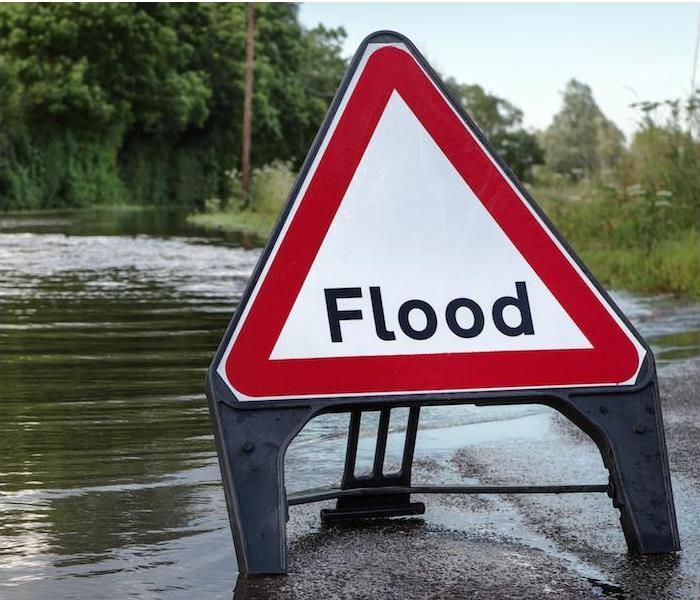 Regardless of the cause of the flooding, SERVPRO of Gwinnett County South has the team to help you recover from any disastrous event.
Regardless of the cause of the flooding, SERVPRO of Gwinnett County South has the team to help you recover from any disastrous event.
Floods are the most common natural disaster in the United States, and they claim more lives each year than hurricanes, tornadoes or lightning. There is a risk of flooding everywhere but especially in areas that experience a large amount of rainfall.
Flooding is present in all states and U.S. territories and presents similarities in types and causality. There are three common types of flooding that happen for four usual reasons.
The Types of Natural Flooding
Flash floods are common and occur when heavy rain passes or sits over an area and overwhelms the ground’s ability to control the moisture. Excess water can sweep away items, big or small, or even people who might get caught in the current.
River floods are exactly what they sound like. When there’s too much water for a river’s banks to hold, the water spills over the sides and causes destruction.
Coastal floods happen in areas next to large bodies of water, when storm surges or cyclonic activity causes ocean or gulf levels to rise to flood levels.
Natural Flooding and the Most Common Causes
Heavy rainfall. Flash floods and river flooding can result from storms with excessive rainfall, or storms that sit and rest in an area for an extended period. Urban areas are more at risk for rain floods, because the higher percentage of concrete and asphalt means there’s a lack of soil to soak up all that water.
In 2021, Atlanta saw a total of 53.65 inches of rain, compared to the U.S. average of 30.21 inches. In February of this year, Gwinnett County experienced a significant amount of rainfall that lead to the temporary closure of Liliburn’s Camp Creek Greenway. It was enough to cause the flood-related problems on the Rockbridge portion of the trail. Many trails around metro Atlanta are vulnerable to weather events.
Oceanic activity. Storm surges, hurricanes and rising tides can cause the water levels to rise, which can inundate coastal communities and cause havoc.
Dams and levees failing. A recent example would be the disastrous levee breaks during 2005’s Hurricane Katrina. When cracks develop in levees or dams, excess pressure overwhelms the ability of the dam to hold back the surge of water behind it.
Snowmelts and ice dams. During the winter, in areas where snow and ice can accumulate due to prolonged freezing temperatures, the snow and ice will melt, allowing the water to flow throughout the area. Ice dams or ice jams occur when rivers become blocked by built-up ice being carried downstream, causing the banks to overflow.
Regardless of the cause of the flooding, SERVPRO has the tools and teams to help your home or business recover from its disastrous effects. Contact us anytime when flooding or water damage makes a mess in your life.
The Timeline of Your Water Damage Repair | SERVPRO® of Gwinnett County South
1/6/2022 (Permalink)
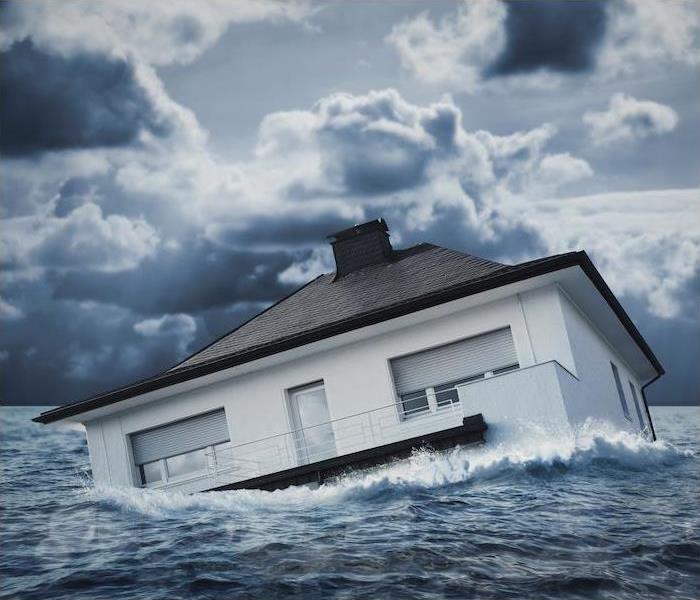 When water damage strikes, make the call to SERVPRO of Gwinnett County South for A-to-Z cleanup and restoration.
When water damage strikes, make the call to SERVPRO of Gwinnett County South for A-to-Z cleanup and restoration.
The annoyance and ruination of water damage happens to U.S. homeowners a troubling 14,000 times a day. Statistically speaking, it’s happening at least once somewhere in America while you read this paragraph. And there it goes again.
Obviously, we hope your home stays bone dry as long as you live there, but should the day arise when you need emergency assistance from SERVPRO, here’s how all that will go.
Emergency Contact. When you reach out in a panic, we’ll reassure you and walk you though some guiding questions to help us understand the situation and start putting a plan together. Then we’ll set a time to meet in person. All of this will happen quickly.
Inspection and Water Damage Assessment. Once we arrive on the scene, we can flesh out the plan and stop any water that may still be flowing. We’ll make sure you know if the encroaching water has created any hazards on your property, and we’ll also give you an idea of the items or materials that will likely need replacement.
Water Removal. You’ll never get all that water out with a bucket or a regular water vacuum. That’s why we bring our pumps to make quick work of it.
Damaged Material Removal. The items that are unable to be restored can now be hauled away, expediting the process of restoration for the items and materials that remain.
Cleaning, Sanitizing and Deodorization. Water damage can leave a yucky mess. We’ll use our tools and some old-fashioned elbow grease to rid your home of unwanted stains, smells and depending on the nature of your emergency, harmful contaminants.
Drying. It’s only a short while after water invades that mold begins to grow. Even after the water is pumped out, your home will need some dehumidifying and drying out.
Monitoring. We’ll be carefully watching the entire process, making sure every box is ticked and every surface is cleaned and dried. Don’t you worry about a thing.
Repairs and Construction. Now that everything is dry and in order, we can go about the finishing touches, which may range from replacing carpet to reconstructing entire rooms. Large or small, we’ll be there to oversee every aspect of your water damage restoration.
When water damage strikes, make the call to SERVPRO for A-to-Z cleanup and restoration. We’ll make your damaged property look “Like It Never Even Happened.”
These Water Damage Figures Will Surprise You | SERVPRO® of Gwinnett County South
12/9/2021 (Permalink)
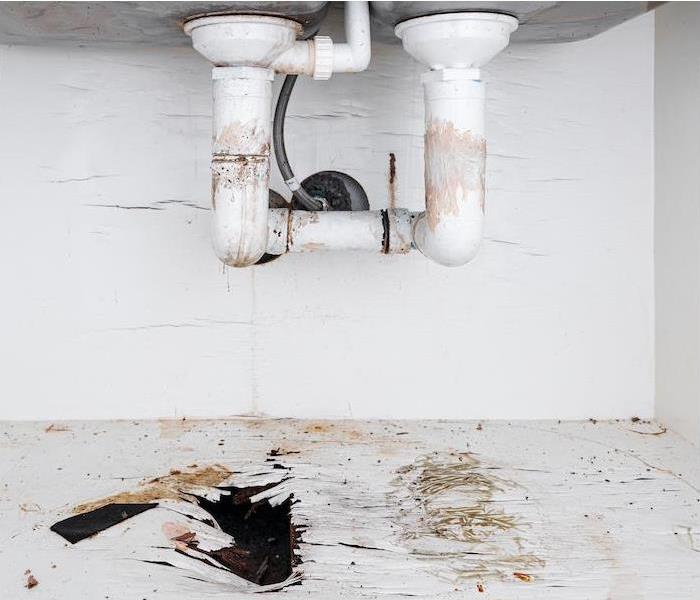 If water damage catches you off-guard and leaves you all wet, you’ve got help on your side. Contact SERVPRO of Gwinnett County South.
If water damage catches you off-guard and leaves you all wet, you’ve got help on your side. Contact SERVPRO of Gwinnett County South.
Don’t panic, but there’s a water war being waged in your home. You may not see it, but every day it’s happening—your pipes, hoses and water appliances are keeping up the valiant effort of not only transporting your water from place to place, but keeping it in line and making sure it doesn’t spew all over the place and wreck your home.
All that water is a good thing, and it’s something you need and rely on every day. But if it gets out of place, it can quickly cause intense damage—that’s why it’s so important to have a well-equipped and maintained plumbing system.
These water damage numbers are ridiculous—let’s read ‘em and weep together.
24. This matches the percentage of all U.S. home insurance claims that happen because of water damage. One in every 50 homeowners will file a claim this year.
48. You have this many hours to get rid of water and moisture before mold growth begins, and in some cases you may have even less time than that.
98. We’d love to say this is the percentage of homeowners who avoid water damage if they think happy thoughts, but it’s not so great—this is the number out of every 100 homes whose basements will take on some kind of water damage during the life of the home.
10,234. Take a guess—did you guess this is the average amount spent to recover a home water incident? Of course you did; great job.
14,000. You know that little square on a calendar that goes around today’s date? Inside that square live 14,000 little pipes that burst and floods that find their way inside homes, because that’s how many times water damage will occur today across the U.S.
13,000,000,000. This number—13 billion dollars—is the amount spent every year repairing and restoring water damage claims in homes.
These numbers are mind-blowing, and they can be a little deflating. But maintaining your home plumbing system and taking care of leaks and moisture right away can help keep you outside these soggy statistics.
If water damage catches you off-guard and leaves you all wet, you’ve got help on your side. Contact SERVPRO to see how we can quickly and fully restore water damage to your home or business.
What You Should Know Before Choosing a Service Company | SERVPRO® of Gwinnett County South
10/8/2021 (Permalink)
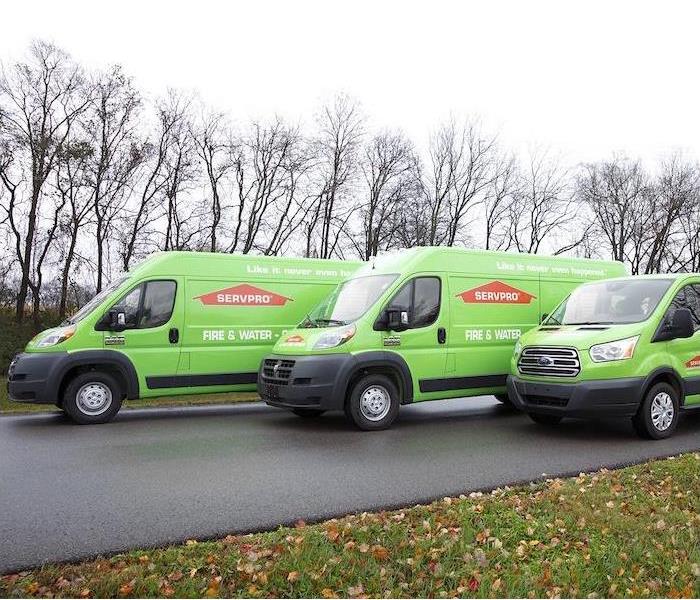 You can rest easy knowing you’ve got the trusted leader in the restoration industry on the other end of the line, SERVPRO of Gwinnett County South.
You can rest easy knowing you’ve got the trusted leader in the restoration industry on the other end of the line, SERVPRO of Gwinnett County South.
Natural disasters, home fires and flooded basements are an unfortunate reality for home and business owners. And when those scenarios present themselves, you’re suddenly forced into some quick decision-making as you try to determine who to trust with the important task of helping you restore or rebuild your property.
It can be difficult in the moment to make a choice, because you may have a glut of options, many of whom provide similar claims for service. But there are some important questions to ask that will help you distinguish a clear choice in your search.
Are They Legit?
When disasters occur, especially disasters that affect a wide area, scammers come out of the woodwork to take advantage. If someone offers you restoration work at a seemingly rock-bottom rate, especially if they have no track record in the area, it’s cause for alarm.
At SERVPRO, we’ve been hard at work for over 50 years, satisfying millions of customers one restored home at a time, and we’ve earned our reputation by keeping promises and providing excellent care.
When prestigious organizations like the PGA Tour entrust us to care for their gorgeous facilities with a meticulous attention to detail, you know you’ll be in good hands when you reach out to us for help at home.
Will They Be There When I Need Help?
If a pipe bursts at night or on a holiday, do you want to wait until the next business day to get help while your carpet soaks in more moisture and mold sets in? We doubt it.
That’s why you can always get in touch with us for emergency service. Your crisis is our crisis, too.
Where’s a Fleet When You Need One?
SERVPRO of Gwinnett County South is locally operated, based right here in the backyard, and that gives us the edge in providing fast, specific expertise for your situation.
But if something more large-scale is needed, we’ve got the full national network of SERVPRO elite teams upon whom we can call for backup and additional help.
When you call SERVPRO, you can rest easy knowing you’ve got the trusted leader in the restoration industry on the other end of the line. When disaster hits home, contact us to get our local experts and nationwide network on your side.
Catch Water Damage Before It Occurs | SERVPRO® of Gwinnett County South
9/20/2021 (Permalink)
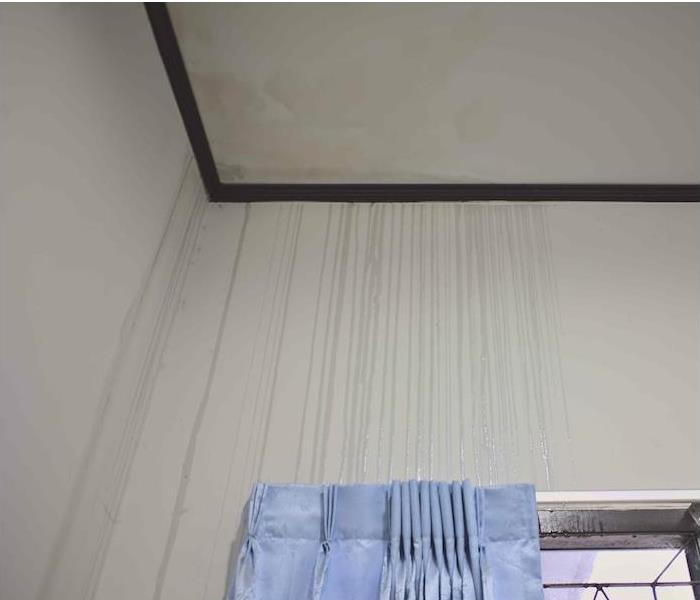 A water leak can turn into a big problem. Contact the SERVPRO of Gwinnett County South team if you are dealing with any water damage.
A water leak can turn into a big problem. Contact the SERVPRO of Gwinnett County South team if you are dealing with any water damage.
Nobody plans for water damage. There’s no water damage “season” we all look forward to like winter holidays—“Ooh, I hope we get a new refrigerator supply hose leak this year!”
And yet, water damage happens on occasion whether we want it to or not. And though it may not choose a defined date or time to occur, if you’re watchful, you may be able to catch some of its likely manifestations before they happen. Let’s check a few spots.
Toilets. There are only a few spots to check your toilet for leaks, and the most common are the flapper (inside the upper tank where the water flows into the bowl) and the valve seal, the rubber ring on the underside of the tank.
Appliances. Any appliance that uses water is going to use hoses and washers that may give way over time. Keep an eye on your fridge, dishwasher and especially the supply hose for your washing machine. Oh, and how old is your water heater? Units over 10 years old have been known to explode.
Clogged gutters. This is one scenario over which you can exert a great deal of control, because it’s a fairly simple matter to check your gutters occasionally and clean out the debris, dirt and leaves that would work together to cause a dam to form in your gutters. Now where’s that ladder?
Roof damage. Your roof’s job is tough. It works hard day after day, taking a beating from the elements, falling tree limbs, squirrels, all kinds of things. Eventually, even the stoutest roof will show signs of wear, and that wear will allow water to pass through to the wood frame and inside to the attic.
Pipes. Pipes can burst in the winter as frozen water expands inside, and other issues like oxidation or loose joints can cause them to fail at other times. You may even have to deal with tree roots intruding into in-ground lines between your house and the main supply at the street.
Blocked garbage disposals. Grease, potatoes and fibrous vegetable skins can all clog your garbage disposal, causing backups and potential damage. And be careful when you plunge, because if your sink’s joints aren’t fully secure (this happens often with PVC), they may separate with intense plunging.
You can’t stop every leak, even at your most vigilant. But keeping an eye on the condition of the various devices that interact with water regularly can make water damage prevention more of a likelihood.
If a water leak erupts into a big problem at home, you’ve got the best team in the business on your side. Contact SERVPRO today so we can get started.
Signs Your Basement May Be Water-Damaged | SERVPRO® of Gwinnett County South
5/21/2021 (Permalink)
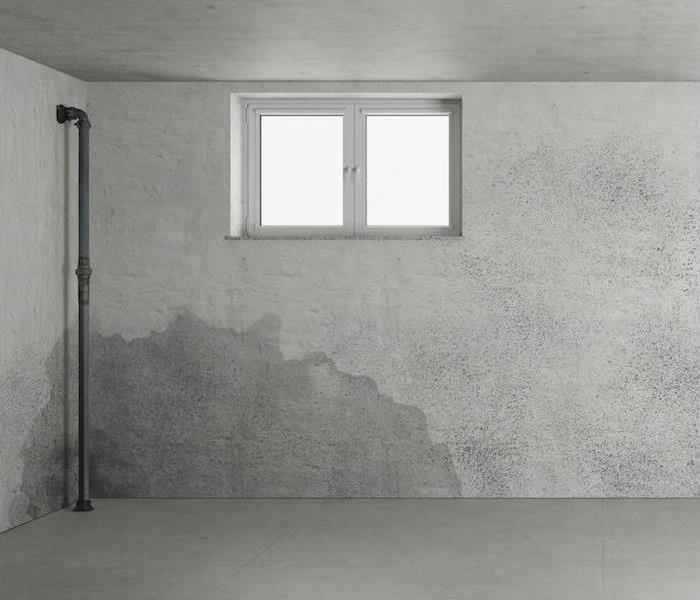 SERVPRO of Gwinnett County South is a full restoration company. Our team is on call and ready to help you determine the best course of action.
SERVPRO of Gwinnett County South is a full restoration company. Our team is on call and ready to help you determine the best course of action.
A basement can be a helpful, useful addition to your Gwinnett home. It can serve as a storage area for your Pokémon collection, your old comic books or your baseball cards. You can make space for your drum set or your flower business, or you can furnish it with a couch bed for your college student who needs a place to chill during the summer.
Basements are versatile, to be sure—but whatever their configuration, they do have an Achilles’ heel, in the form of accumulated moisture. Because they’re dug out of the ground, they are prone to take in water over time from the surrounding soil.
While it’s not guaranteed that you’ll experience water damage, you can’t have those Pokémon cards getting damp, so it’s good to know what you’re up against and what you’re looking for.
So let’s examine the most common signifiers of basement water damage, and if you discover that these are happening in your own basement, you know where to turn for fast, reliable remediation.
The Most Common Water Damage Signs
Unpleasant, musky odors. Though the water that leaks inside your basement may not be unclean to begin with, it can quickly allow bacteria to grow as it settles in, and when it begins to evaporate, it will give off a musky smell. Many people just operate under the assumption that basements naturally smell this way, but that shouldn’t be the case. This smell indicates that mold and mildew are present in the environment, and you definitely don’t want to be dealing with that. You may not see them right away, but your nose is telling you there’s a problem.
Flaking paint on masonry or walls. Bubbles, flakes and cracks in your interior paint are sure signs that water has found its way inside. Even if your blocks or walls are coated with so-labeled waterproof paint, eventually they will be unable to hold back the proof. Water finds a way in and down, and no paint will hide it forever.
Foundational cracks. While homes do shift over time, large cracks in the foundation aren’t normal, and they could be signs of a big water leak that has gone unnoticed. Cracks can also show up in the floor, the ceiling or in your walls, indicating that your structure is under pressure because of an unstable foundation. Hairline cracks inside aren’t a major worry, but if they start to grow, get them looked into right away.
If you notice any of these signs in your basement, let us take a look. Our expert water restoration technicians can help you determine what is causing these issues and how to treat it properly. Contact us today to learn more.
Protect Your Snellville Home From Heavy Water Damage | SERVPRO® of Gwinnett County
4/5/2021 (Permalink)
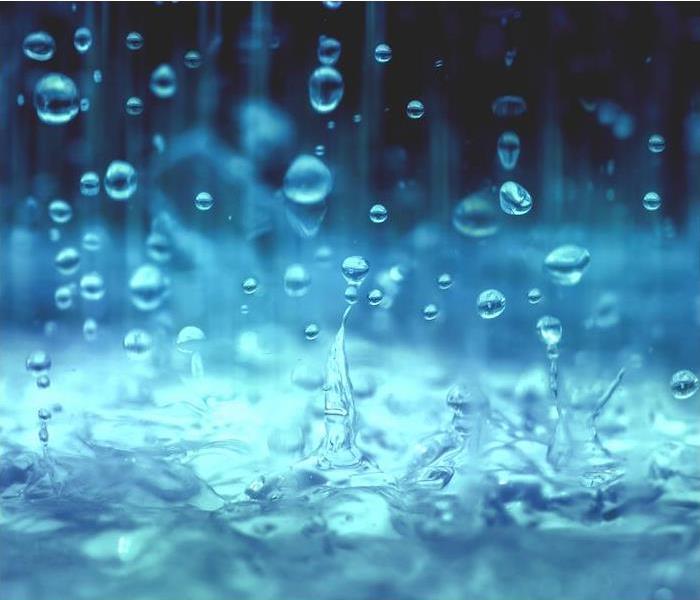 If you need help dealing with any damage caused by water, contact SERVPRO of Gwinnett County South today.
If you need help dealing with any damage caused by water, contact SERVPRO of Gwinnett County South today.
If you’re a homeowner in Snellville, you’ve probably already thought a lot about the ways severe weather (and water) can damage your home.
You probably have a plan in place for flash floods, strong thunderstorms, or home malfunctions like burst pipes or refrigerator line failures. But there are water damage hazards you might not have considered.
Have you thought about the damage heavy rains can do?
You may not have. But rain can damage your home, and rain is more common than natural disasters we dread, like flash floods or tornadoes.
Here’s some good news. Rain damage, in many cases, can be prevented if your home is thoughtfully maintained.
Stopping the Damage From Heavy Rains
Members of our team are experts in water damage. So we see many of the issues that can lead to preventable water damage firsthand.
Our team has some helpful ideas to make your yard and home safer this spring and summer.
Take stock of your yard. Knowing how your yard drains (and how it works with your home) is vital. If you notice that your yard is draining toward your home, then you might want to get in touch with a landscaping expert to look for ways to protect your yard.
Choose to landscape your yard thoughtfully. Many people choose plants and flowers because they like the aesthetic they create. But choosing landscaping items for protection can ensure your home is ready for heavy rain. Native plants, trees and bushes can be vital in protecting your home from water damage.
Consider sealing your roof. Sealing your roof can help protect your home from wind and water damage. In fact, experts estimate that almost 95% of water damage is caused by water seeping through gaps in your roof and shingles, which can be prevented with this step.
If you need help dealing with damage caused by water, fire or any other issue, we’re here to help you restore your home. We have crews who are available 24⁄7 in the event of an emergency. Contact us at any time to learn more about us and how we can help you restore your home to its original state.
Tips for Protecting Your Home This Spring and Beyond | SERVPRO® of Gwinnett County South
3/2/2021 (Permalink)
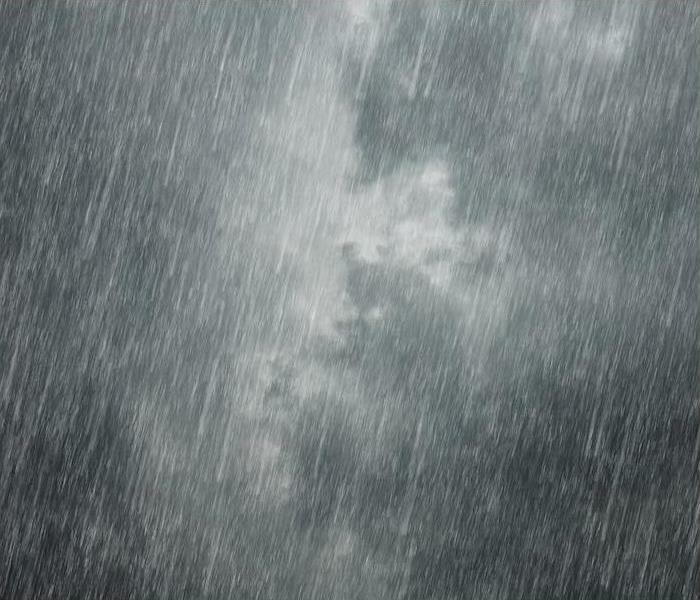 If you experience any property damage from spring storms, contact SERVPRO of Gwinnett County South.
If you experience any property damage from spring storms, contact SERVPRO of Gwinnett County South.
Here in Georgia, we’re lucky that our winters are relatively mild (especially when compared with what our friends in the Midwest and Northeast face). But that doesn’t mean we don’t have spring fever, too.
Inevitably when we flip the calendar from February to March, it’s time to start dreaming about what a new, warmer season will bring.
Gwinnett County residents might want to plant some flowers or tomatoes, plan a barbecue, or drive out to the country and take a hike. It can be as simple as dreaming about pulling your grill out and making some steaks.
While spring brings many great things to our area, it also brings the threat of severe weather and storms.
We can’t control or prevent the weather, but we can make our homes safer. These tips can help you do that.
Making Your Home Safer from Stormy Water
Add these projects to your to-do list today!
Don’t wait to cut heavy limbs or branches hanging over your home. Many people love healthy, mature trees. But when the stems are over your roof or garage, they can fall when the winds get high and heavy. Cut them down.
Check and clear your gutters. This step is so vital we recommend doing this every season. Keep any water that comes near your home moving in the right direction instead of backing up and causing water damage.
Look for any signs of damage to your roof.Specifically, check for any missing shingles or leaks. Repairing them will help protect your home from water damage.
Be sure your home’s sump pump works. Your family may not have or need one of these. But if you do, keeping it working the right way protects your home from water damage.
Don’t leave items around your home loose. Don’t let unsecured furniture or other similar items become tools for wind damage. Trim back trees that need it and ensure everything you can.
If a fire, flood or any other cause damage to your home, you can always count on us for restoration assistance. We are available 24⁄7 in the event of an emergency. Contact us at any time to learn more about our restoration services and how we can help you.
Planning in Advance for a Burst Pipe | SERVPRO® of Gwinnett County South
12/14/2020 (Permalink)
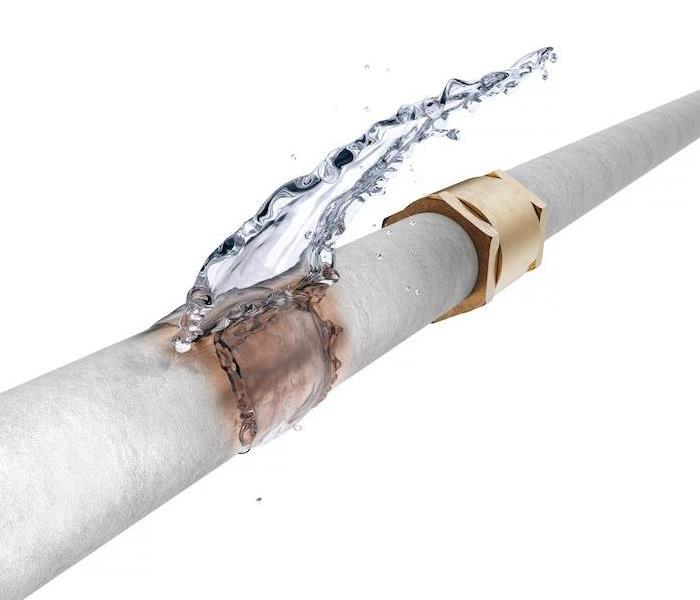 If you have water damage in your home due to a burst pipe or another cause, contact us right away. SERVPRO of Gwinnett County South is available 24/7.
If you have water damage in your home due to a burst pipe or another cause, contact us right away. SERVPRO of Gwinnett County South is available 24/7.
It is never enjoyable to discover your home has undergone water damage, but if you are faced with a burst pipe, it can be quite shocking indeed. Because of the volumes of water they can produce, a burst pipe can lead to significant amounts of damage in a short amount of time.
Most people are surprised to discover just how common water damage can be. It is estimated that every year, at least one out of every 50 homes are impacted by water damage in America, but those who have planned ahead tend to experience much less severe damages.
How Can I Reduce the Damage From a Burst Pipe?
Shut off your water main. If a pipe bursts in your home, the water rushing in will not stop until the water is cut off entirely. Locating and turning off your home’s water at the source can stop the water from rushing into the impacted area.
Shut off your electricity. Making sure your electricity is turned off (if it is safe to reach your breaker box) is a smart way to prevent secondary damages from occurring if water comes into contact with wiring or electronics.
Contact your restoration company. Choosing a restoration company that you can contact 24 hours a day is a great way to ensure you can get in touch immediately should anything go wrong. The faster you start the restoration process, the easier it will be to mitigate the damages.
Take a record of the damages. Recording what has been damaged throughout your home is helpful for you, and will come in handy if you are able to file an insurance claim, too. Pictures, videos and lists can help make sure that nothing falls through the cracks as you begin to recover.
Contact your insurance company. Because each insurance policy is different, contacting your provider as soon as you can will help you determine if you are eligible to file a claim and how to go about it if you are.
Open windows and doors if possible. As you wait for your restoration company, wiping up water and opening windows and doors can aid the drying process and lessen the overall damage that the burst pipe caused.
If you have water damage in your home due to a burst pipe or another cause, you can count on us for restoration assistance. Contact us at any time to learn more about our restoration services.
Water Loss may turn into Mold Remediation
10/23/2020 (Permalink)
One of the most important things about water damage is to treat it quickly. Whether you have sustained a busted pipe or something more serious, if the water damage reached your carpets and was not treated professionally, you still have damage happening right beneath your feet. Mold is growing in your carpets, and you need to take care of it. ASAP.
Mold can start within 24-48 hours of the time of loss in the right environment and conditions. Your home offers a constant food supply to the mold spores. Mold spores feed on wood, drywall, insulation, paper and anything it can get attached on. After a day or more, the mold starts colonizing, creating those big black stains we all know from photos (or from our home, if luck wasn't on our side).
Mold Is Dangerous, Even When Hidden
In most cases, mold will be discovered after it colonizes, and by then its growth is rapid. If you suspect you have mold, you should call a mold expert to check it out. Whether it's a water damage certified technician, a home inspector or an industrial hygienist. The mold usually grows where water damage hit, or where high humidity is found. If water leaked on your carpet - that's where the mold will start growing.
To protect your carpets from mold after they're flooded by water, you should follow the steps below. If it already happened, and you missed one of the steps, you should check your carpets for dark stains or moldy smell. You don't want mold growing under your carpets, in your floors and all around your home.
Steps to prevent mold after water damage:
- Stop the water source - first thing first. Stop the water from flowing in and get them out of your home. If it's a leaky pipe or a broken appliance, close the water main. If it's the roof, try and see if you can get a roofing company to come for an emergency service and close the gap. Once you've stopped the water from coming, you need to get it out.
- Extract the water - to prevent further damage and minimize long term effects, it's important to get the water out. If it's a small amount, you can blot it out or use a mop to absorb it (if on the floor and not carpets). If it's a large amount, get a water mitigation company like SERVPRO of Gwinnett County South to help you with it.
- Get it Dry – Fast! - If you have fans, or you know where you can rent drying fans - go for it. If you need some help with drying your home, we'd be glad to help as well. Call us and let us know what you need. It's important to have the property dried as fast as you can to avoid mold growth, as well as the water being absorbed in carpets, floors, rugs or other items. It's also recommended to use dehumidifiers to lower the humidity in the affected area, especially if you can't air it out properly.
- Steam clean everything you can - carpets, rugs, flooring, furniture - if it had water get to it you want it professionally cleaned right now, before the mold gets comfortable and colonizes. Once the mold sets in, that item is probably lost and will need to be replaced.
- Sanitize the affected area - if you hired a professional damage restoration company, they'll do it as part of the water mitigation process. If you didn't, and decided to solve the issue yourself, you should clean anything that met the water.
WE WILL MAKE SURE THE MOLD IS GONE
If you still feel like your clean-up wasn't enough, or you feel there is mold hiding somewhere - contact us at SERVPRO of Gwinnett County South at 770-448-5782. We'd be more than happy to pay you a visit and provide a professional opinion on the matter.
Remember, it's very dangerous to have mold in your home - mold can have very serious side effects on you and your health. Get your mold remediated as soon as you can.
Make a Water Damage Inspection Part of Regular Home Maintenance | SERVPRO® of Gwinnett County South
9/21/2020 (Permalink)
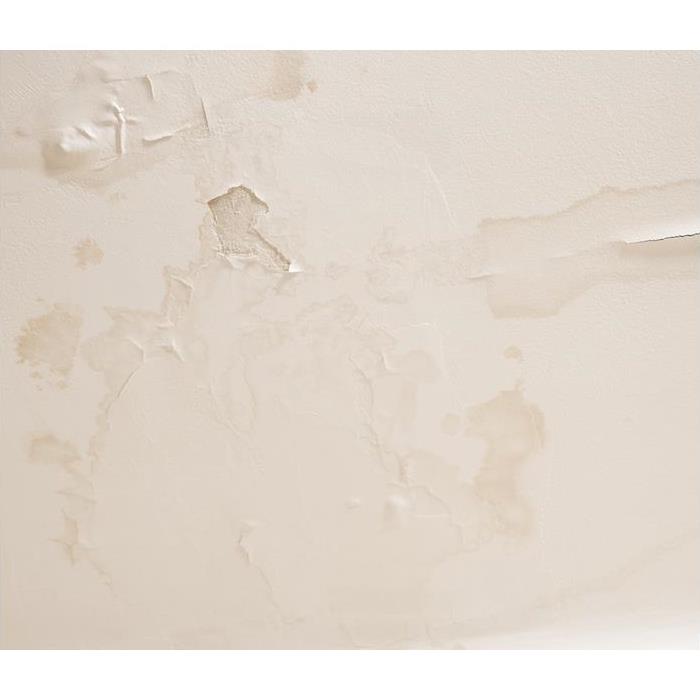 Do you have any water damage to your home? Contact SERVPRO of Gwinnett County South, we are your local water restoration experts.
Do you have any water damage to your home? Contact SERVPRO of Gwinnett County South, we are your local water restoration experts.
There are few things that are worse for a home than the accumulation of water damage that goes untreated. This can lead to a number of issues and cause problems that are more than just cosmetic. Water damage can severely harm the structural elements of a home and cause a whole host of issues that are not readily apparent.
As part of your maintenance tasks around the house, doing a check for water damage on a regular basis is wise. Catching it early will lessen the damage you—and your homeowners’ insurance—have to deal with. If you find evidence of water damage, it is important to call in the restoration professionals right away.
Looking for Evidence of Water Damage Around the House
Inspect your walls and ceilings. If there is a leak in the ceiling or behind the walls, your drywall will often be the first place to show it. Spots of discoloration or peeling paint are often signs of a hidden leak festering, and can quickly be noticed with even a preliminary DIY inspection of the area.
Don’t forget to look down. Your floors can often show evidence of water damage early on, as well. As the water flows downward from where it is originating, it can work its way to the subfloor which can absorb a good bit of moisture. This will cause the subfloor to swell, leading to buckling and softening of the cosmetic floor above.
Inspect your roof. Your roof serves as your first line of defense against any weather-related issue, which is why keeping it operational is so important. Go out with a pair of binoculars after every storm to check for missing shingles, loose flashing or other signs of trouble. It is also smart to check in on your gutters when it rains so you can watch out for drainage issues.
Pay close attention to the basement. Basements were always considered to be a damp area in the past, but now we know how much damage can be done by letting basement moisture go unchecked. Water can seep in through the walls if drainage is poor, holding moisture in and leading to mold and mildew growth. Basement moisture is no joke, and should always be addressed by a professional.
If you have water damage anywhere in your home, we are here to help. You can contact us at any hour to learn more about our services or to report damages. Get in touch today to speak with a water damage restoration expert.
A Water Loss can Lead to Mold
6/17/2020 (Permalink)
One of the most important things about water damage is to treat it quickly. Whether you have sustained a busted pipe or something more serious, if the water damage reached your carpets and was not treated professionally, you still have damage happening right beneath your feet. Mold is growing in your carpets, and you need to take care of it. ASAP.
Mold can start within 24-48 hours of the time of loss in the right environment and conditions. Your home offers a constant food supply to the mold spores. Mold spores feed on wood, drywall, insulation, paper and anything it can get attached on. After a day or more, the mold starts colonizing, creating those big black stains we all know from photos (or from our home, if luck wasn't on our side).
Mold Is Dangerous, Even When Hidden
In most cases, mold will be discovered after it colonizes, and by then its growth is rapid. If you suspect you have mold, you should call a mold expert to check it out. Whether it's a water damage certified technician, a home inspector or an industrial hygienist. The mold usually grows where water damage hit, or where high humidity is found. If water leaked on your carpet - that's where the mold will start growing.
To protect your carpets from mold after they're flooded by water, you should follow the steps below. If it already happened, and you missed one of the steps, you should check your carpets for dark stains or moldy smell. You don't want mold growing under your carpets, in your floors and all around your home.
Steps to prevent mold after water damage:
- Stop the water source - first thing first. Stop the water from flowing in and get them out of your home. If it's a leaky pipe or a broken appliance, close the water main. If it's the roof, try and see if you can get a roofing company to come for an emergency service and close the gap. Once you've stopped the water from coming, you need to get it out.
- Extract the water - to prevent further damage and minimize long term effects, it's important to get the water out. If it's a small amount, you can blot it out or use a mop to absorb it (if on the floor and not carpets). If it's a large amount, get a water mitigation company like SERVPRO of Gwinnett County South to help you with it.
- Get it Dry – Fast! - If you have fans, or you know where you can rent drying fans - go for it. If you need some help with drying your home, we'd be glad to help as well. Call us and let us know what you need. It's important to have the property dried as fast as you can to avoid mold growth, as well as the water being absorbed in carpets, floors, rugs or other items. It's also recommended to use dehumidifiers to lower the humidity in the affected area, especially if you can't air it out properly.
- Steam clean everything you can - carpets, rugs, flooring, furniture - if it had water get to it you want it professionally cleaned right now, before the mold gets comfortable and colonizes. Once the mold sets in, that item is probably lost and will need to be replaced.
- Sanitize the affected area - if you hired a professional damage restoration company, they'll do it as part of the water mitigation process. If you didn't, and decided to solve the issue yourself, you should clean anything that met the water.
WE WILL MAKE SURE THE MOLD IS GONE
If you still feel like your clean-up wasn't enough, or you feel there is mold hiding somewhere - contact us at SERVPRO of Gwinnett County South at 770-448-5782. We'd be more than happy to pay you a visit and provide a professional opinion on the matter.
Remember, it's very dangerous to have mold in your home - mold can have very serious side effects on you and your health. Get your mold remediated as soon as you can.
Water Restoration in Your Home
6/14/2020 (Permalink)
When heavy rains and high winds hit hard, property destruction and loss can be devastating to you as a homeowner. Structural damage to the exterior of your home is followed by interior devastation from water and winds. Storm damage is rarely isolated to just a few buildings in an area adding the challenge of finding a restoration company that can respond swiftly to your needs to an already anxiety provoking situation. SERVPRO of Gwinnett County South delivers the help you need swiftly, even when a local disaster is widespread as we can call upon a network of over 1,650 franchises nationwide to respond if the need is great. Storm damage can feel overwhelming, but your fear and panic will disappear when our team of professionals responds to your water, wind, and flooding repair fulfilling your restoration needs. Your particular situation is of paramount importance to us, and you need not worry that your repairs and restoration will take a back seat even when many in your area are struggling to recover from the same issues you face. Choosing our company puts in motion a vast support system, but our local ownership means you will receive a personalized approach to your particular situation, efficiently returning your home back to its pre-storm condition just “Like it never even happened.” Placing your trust in SERVPRO of Gwinnett County South for your storm damage needs will reap you benefits that less qualified companies simply cannot deliver. We use state of the art equipment to clean, repair, and restore your home and in the process, we also restore your and your family’s peace of mind. Our technicians are highly trained and qualified, current in Institute of Inspection Cleaning and Restoration Certification (IICRC) for any procedure needed to bring your home back to the comfortable and comforting refuge you deserve. We also work closely with your insurance company, ensuring that all the work necessary is approved and compensated according to the terms of your policy. Our high standards and relentless drive to do the job on time while meeting local specifications means you and your family will quickly return to the quiet enjoyment of your house and neighborhood. We are not satisfied until you are happily back in your restored dwelling. Once you make sure that your family is safe after a major storm, your first call should be to SERVPRO of Gwinnett County South. Dial 770-448-5782 24/7 and begin the road to recovery by scheduling an inspection with our storm damage experts.
The 6 Steps to Water Restoration SERVPRO of Gwinnett County South
4/29/2020 (Permalink)
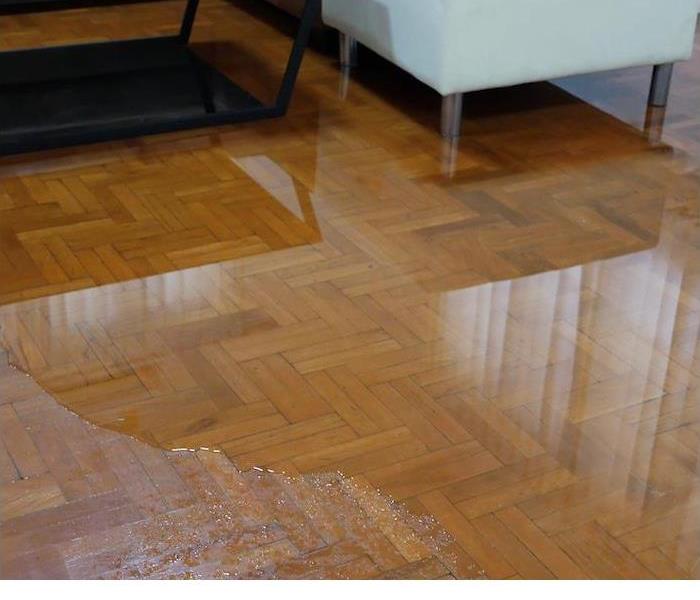 Water loss in home.
Water loss in home.
There is nothing that can prepare you for the emotional impact of water damage, but you should act fast when it does happen.
You can call us 24 hours a day to set the restoration process in motion so you can recover as quickly as possible from water damage. Here’s what the process is like:
6 Steps to Water Damage Restoration
1. Initial Emergency Contact
There is no typical time for water damage to occur, which is why we are available 24 hours a day to answer your call for restoration. Over the phone, we will obtain pertinent details about your situation and draft a plan to ensure you receive the equipment and staff you need.
2. Inspection and Damage Assessment
Once we arrive at the scene, we will check immediately for safety hazards to ensure you are not in harm’s way, and stop any excess water flow if applicable. Then we will do a complete damage assessment and create a plan for restoration custom to your situation.
3. Moisture Extraction
Removing moisture from the impacted area is one of the highest priorities next to safety, which is why we move on to this step as quickly as possible. We have the equipment to remove hundreds of gallons of water at a time to ensure we can handle water damage of any size.
4. Dehumidifying and Drying
After removing the excess moisture from the area, we will start dehumidifying the air and drying out belongings and surfaces that have absorbed moisture. This is important because inadequate moisture removal can lead to strong odors and persistent mold and mildew growth on objects.
5. Cleaning Belongings
Items that have been impacted by water damage can be contaminated even if they have not absorbed water, which is why we clean everything that may have been infected. We practice the highest standards of sanitization and deodorization so you have no lingering reminders of the damages.
6. Restoration and Repair
You can not only count on us for moisture removal, but you can depend on us for a complete restoration process, including any structural or cosmetic repairs required. From patching drywall to installing new floor treatments, we can fully restore your home or office to how it was before the damage.
If your home has been water-damaged, you can count on us to help. Call us 24⁄7 to get the process started.
How Hidden Water Leaks Can Surface From Appliances | SERVPRO® of Gwinnett County South
3/2/2020 (Permalink)
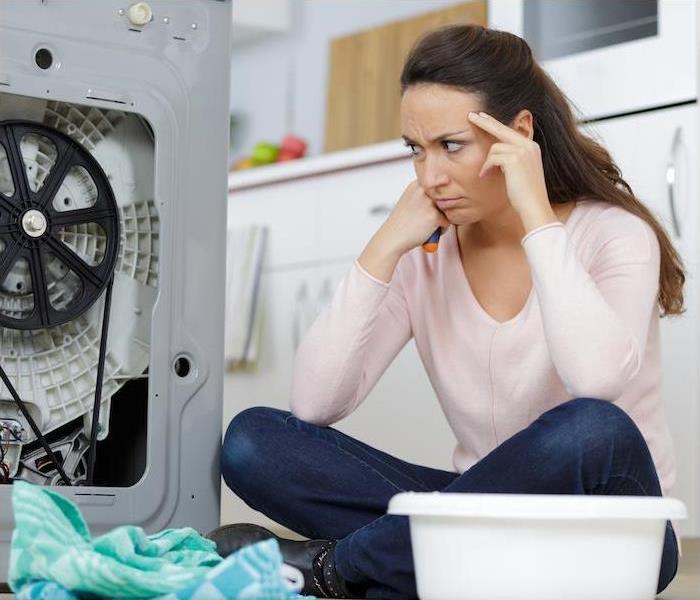 A leaky appliance can lead to frustration.
A leaky appliance can lead to frustration.
Water damage is an increasingly common problem, but did you know that one of the most common causes of water leaks comes from right inside the home?
Appliances such as refrigerators, dishwashers and washing machines utilize large volumes of water each day, leading to water damage that often remains hidden for a while before homeowners are ever made aware. Fortunately, we’ve got the guide to help you check and prevent leaks from getting out of hand.
Common Appliances That Lead to Water DamageHot Water Heater
Hot water heaters are typically designed to last for up to 15 years, but leaks can begin much earlier. Because of their design, faulty materials or installation can cause the heater’s elements to break down over time. Staying aware of how it’s operating and replacing on schedule is important for prevention.
Refrigerator
The most common type of water line that runs to a refrigerator is a kind made of bendable plastic, which is a material prone to tears and sealant issues. Because of this, hidden leaks can arise. Due to the fact that refrigerators are rarely moved, these leaks can go on for a long time before homeowners are aware. Regular inspections are the best prevention method.
Dishwasher
Along the same vein, dishwashers are typically only moved when they need replacement, which can reveal water damage years in the making. Make a point to check behind yours often, especially because there are many situations where water damage is not covered by insurance and it is better to catch it early to avoid serious issues.
Washing Machine
Washing machines are one of the most common places for homeowners to get leaks. They are so prone to them that experts recommend checking their hoses for leaks once a month at minimum. The hoses should also be replaced every five years regardless of if they have visible aging.
Air Conditioner
HVAC units commonly create condensation, and as long as they are draining properly, there is no cause for concern. Unfortunately, once an issue arises with this system, water can become backlogged in and around the unit and cause damage. Keeping up with your recommended maintenance is the best prevention method, as well as checking the unit for anything amiss.
If your home has been impacted by water damage or you’d like to put a plan in place in case it happens to you, contact us to learn how we can help.
Water Damage Prevention | SERVPRO® of Gwinnett County South
10/28/2019 (Permalink)
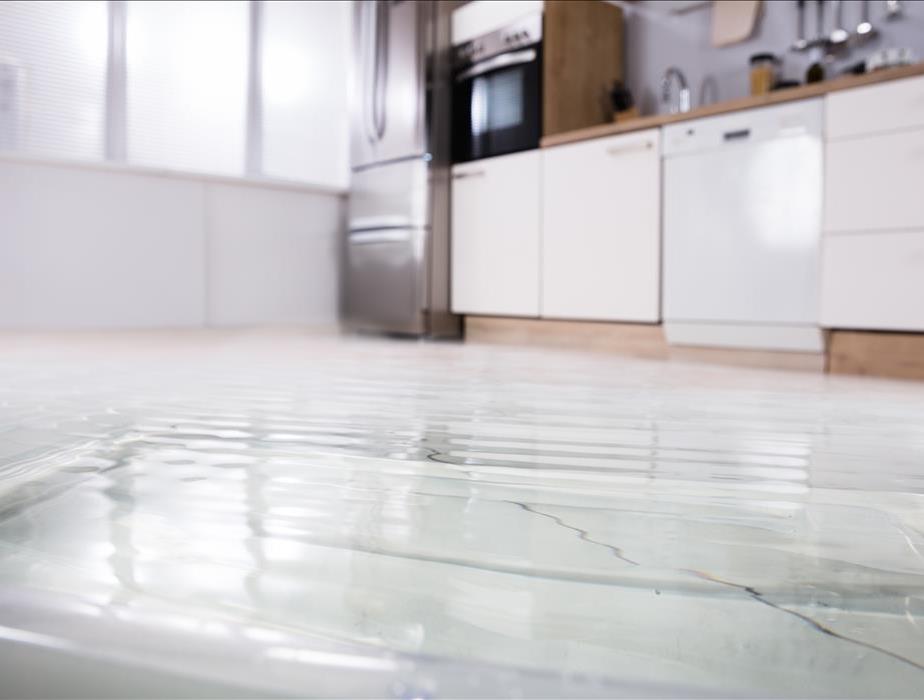 Water damage throughout the kitchen floor.
Water damage throughout the kitchen floor.
Many homeowners know about the dangers of fires or thunderstorms, but have you considered that flooding could also be a hazard? It is reported that 90% of natural disasters include some form of flooding, making it crucial for homeowners to be informed.
How Can Homeowners Lessen Their Flood Damage Risk?Flooding can cause excessive damage to the unprepared home, and though natural disasters cannot be prevented, these devastating damages sometimes can:
Know your risk. Check in with your local emergency officials and the FEMA Flood Map Tool to understand precautions and risks specific to your location.
Anchor propane and fuel tanks. If a fuel tank tips over due to a flood, it can lead to a dangerous spill or even a fire. Remove fuel tanks from the property or anchor them securely.
Turn off electricity. It might seem unlikely that the floodwaters will interact with the electrical current in the home, but it is a recipe for disaster regardless. Prevent shocks and electrocution by making certain to cut the electricity to affected areas of the home.
Discuss emergency procedures. Make sure your family is aware of the evacuation plan and where to locate emergency supplies in the event that you are not home.
Raise hazardous materials. Chemicals and other hazardous substances are in a lot of everyday household items. Elevating these substances will allow you to keep them from polluting the water in your home.
Prepare appliances. Using household objects, elevate appliances to prevent their internal workings from becoming waterlogged.
In the event of a disaster, keeping your family safe is most important. Take advance precautions and plot out evacuation procedures ahead of time to help protect your home from extensive water damage and protect your family from danger as well.
If you’ve experienced water damage due to a flood or other causes, SERVPRO® of Gwinnett County South is here to help. Our fully trained water remediation technicians will be there for you when you call.
Places to Be on Guard for Water Damage | SERVPRO® of Gwinnett County South
9/24/2019 (Permalink)
Water damage can happen as a result of severe weather, but it can also happens for a variety of other reasons. Weather-related causes are the most familiar, but certainly are not the only cause homeowners should be concerned with.
Water damage is both a complicated and costly endeavor. Many homeowner’s insurance policies do not cover water damage, and when they do, the average claim totals nearly $7,000. Knowing the places to be on guard for water damage is wise for homeowners and can help them avoid unnecessary expenses.
Where to Look for Water DamageThe cabinets under the sink. The area under a sink can often hide small drips, which can turn into big water damage and give rise to mold in the dark, damp area.
Behind the tub casing. The caulk that seals tubs will wear out over time, leaving a perfect crack for water to slip through.
Behind drywall. Drywall is made to hide the structure of the home, but it can also hide water damage to that structure—especially following floods or burst pipes elsewhere in the home.
At roof intersections. The seals around common roof intersections such as chimneys and exhaust fans are designed to keep out water but are not designed to last forever.
Inside an AC unit. The line that drains condensation from the air conditioning unit can become clogged, causing a backup that dispenses water inside of the unit instead.
Beneath appliances. Washing machines and dishwashers pump a large volume of water into and out of the house and can cause hidden leaks that lead to costly repairs.
Behind exterior faucets. A house’s siding can easily hide a leak from an exterior faucet, which can occur when its bond to the water pipe falters.
If your home has suffered water damage (even in a hidden place like one of these), we are happy to help! Give us a call right away, and we’ll get there quickly.
Faulty Hot Water Heater | SERVPRO® of Gwinnett County South
6/19/2019 (Permalink)
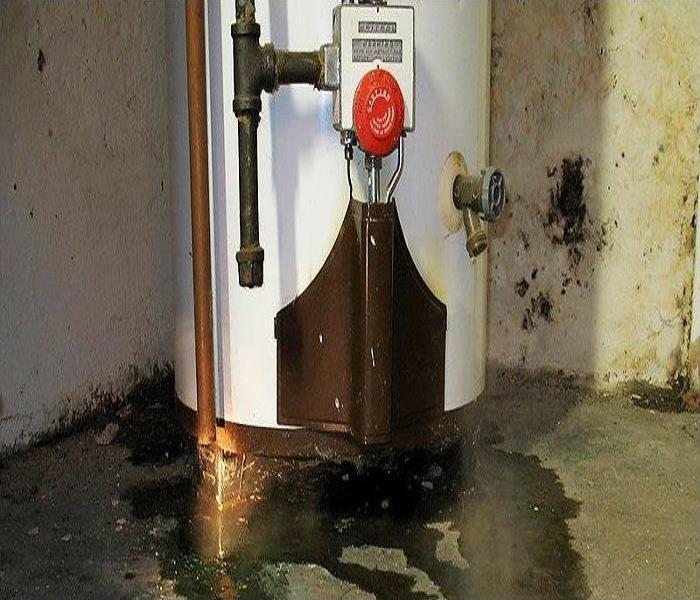 A leaking water heater is no fun!
A leaking water heater is no fun!
Water can damage your home in many ways. Most of the time it's an external threat, but sometimes a leak from inside can cause just as much, or even more, damage. When a leak develops, the water might not come rushing out at once. Most of the time it's a slow leak that may go unnoticed for days.
If the water heater is located on an upper floor, the damage will be even more extensive, since water always flows downhill. The leaking water heater on a second floor can cause extensive damage to both walls and flooring as the water seeks the lowest spot in the building or home.
Fortunately, there are steps people can take to minimize the risk of a water heater causing damage to their home or business. The first thing people need to do is regularly inspect the water heater and the pipes around the unit for any signs of leakage, moisture, mold, mineral buildup and corrosion. Putting in an inexpensive drip pan below the water heater that drains to the outside of the property can help prevent thousands of dollars in water damage in many cases.
Age is also a big factor. Many water heater manufacturers estimate the lifespan of these appliances to be 8 to 12 years, so replacing a unit when it is nearing this age can be a good insurance policy against unwanted damage.
What to look for:
- Water doesn't get as hot as it used to.
- There's rust in water coming from your faucets or on your clothes.
- Your hot water heater makes cracking and popping sounds when it's heating.
- There's a metallic taste in your hot water.
- Rust is forming on the outside bottom of your water heater.
- A puddle is forming under your hot water heater.
- The burner units have become clogged or rusty.
Unfortunately, leaking water heaters result in countless insurance claims each year. If a small leak goes unnoticed – occurring while you are on vacation, for example – the damage can quickly escalate into a major claim. Call SERVPRO® of Gwinnett County South at 770-448-5782 if you experience water damage caused by a faulty hot water heater.
Water Damage Timeline | SERVPRO® of Gwinnett County South
6/15/2019 (Permalink)
Water intrusion into your Loganville, GA home or business requires a fast response to mitigate the damage. Let’s examine how water damage can affect your home or business over time:
First Sixty Minutes
- Water is invasive and can quickly spread throughout the structure, finding the least path of resistance.
- Water saturates the structure, getting under flooring, behind cabinets and into walls and ceilings.
- Dyes on paper goods may bleed.
First 24 Hours
- Drywall starts swelling and breaking down.
- Wood furniture begins to swell and crack.
- Metal surfaces may begin tarnishing.
- Musty odors begin to intensify.
- Inks and dyes continue spreading.
48 Hours to 1 Week
- Mold may begin to develop and spread.
- Doors, windows, casing and wood structure begin to swell and warp.
- Wood flooring may swell and buckle.
- Metals begin to rust and corrode.
- Flooring adhesives begin to break down and release.
- Restoration expense has increased.
After 1 Week
- Structural safety concerns may be present.
- Health concerns may arise requiring relocation of occupants.
- Restoration time and cost have dramatically increased.
Often water damage goes unnoticed when it is caused by a leak underneath a cabinet, behind the refrigerator or in your attic or basement. Many times, you are not physically able to identify where the water migrated. If you find water leaking in your home or business, go ahead and call a professional to come find out the extent of the problem. Remember even small leaks follow the Water Damage Timeline.
When Water Damage Strikes
4/29/2019 (Permalink)
One of the most important things about water damage is to treat it quickly. Whether you have sustained a busted pipe or something more serious, if the water damage reached your carpets and was not treated professionally, you still have damage happening right beneath your feet. Mold is growing in your carpets, and you need to take care of it. ASAP.
Mold can start within 24-48 hours of the time of loss in the right environment and conditions. Your home offers a constant food supply to the mold spores. Mold spores feed on wood, drywall, insulation, paper and anything it can get attached on. After a day or more, the mold starts colonizing, creating those big black stains we all know from photos (or from our home, if luck wasn't on our side).
Mold Is Dangerous, Even When Hidden
In most cases, mold will be discovered after it colonizes, and by then its growth is rapid. If you suspect you have mold, you should call a mold expert to check it out. Whether it's a water damage certified technician, a home inspector or an industrial hygienist. The mold usually grows where water damage hit, or where high humidity is found. If water leaked on your carpet - that's where the mold will start growing.
To protect your carpets from mold after they're flooded by water, you should follow the steps below. If it already happened, and you missed one of the steps, you should check your carpets for dark stains or moldy smell. You don't want mold growing under your carpets, in your floors and all around your home.
Steps to prevent mold after water damage:
- Stop the water source - first thing first. Stop the water from flowing in and get them out of your home. If it's a leaky pipe or a broken appliance, close the water main. If it's the roof, try and see if you can get a roofing company to come for an emergency service and close the gap. Once you've stopped the water from coming, you need to get it out.
- Extract the water - to prevent further damage and minimize long term effects, it's important to get the water out. If it's a small amount, you can blot it out or use a mop to absorb it (if on the floor and not carpets). If it's a large amount, get a water mitigation company like SERVPRO of Gwinnett County South to help you with it.
- Get it Dry – Fast! - If you have fans, or you know where you can rent drying fans - go for it. If you need some help with drying your home, we'd be glad to help as well. Call us and let us know what you need. It's important to have the property dried as fast as you can to avoid mold growth, as well as the water being absorbed in carpets, floors, rugs or other items. It's also recommended to use dehumidifiers to lower the humidity in the affected area, especially if you can't air it out properly.
- Steam clean everything you can - carpets, rugs, flooring, furniture - if it had water get to it you want it professionally cleaned right now, before the mold gets comfortable and colonizes. Once the mold sets in, that item is probably lost and will need to be replaced.
- Sanitize the affected area - if you hired a professional damage restoration company, they'll do it as part of the water mitigation process. If you didn't, and decided to solve the issue yourself, you should clean anything that met the water.
WE WILL MAKE SURE THE MOLD IS GONE
If you still feel like your clean-up wasn't enough, or you feel there is mold hiding somewhere - contact us at SERVPRO of Gwinnett County South at 770-448-5782. We'd be more than happy to pay you a visit and provide a professional opinion on the matter.
Remember, it's very dangerous to have mold in your home - mold can have very serious side effects on you and your health. Get your mold remediated as soon as you can.
Oh No! A Pipe Burst, What Next?
3/4/2019 (Permalink)
It might be the sound of dripping water on the ceiling or behind a wall, or a mysterious puddle on the floor. Maybe you've noticed a decrease in water pressure when you turn on the hot water faucet, or no water flow whatsoever. These are all signs that a pipe may have burst.
It only takes a small hole to cause you big problems when the water starts to melt.
Pipe Bursts Can Be Destructive
They happen most often in the wintertime, when water freezes inside - outdoor plumbing or in pipes near exterior walls. As the water freezes, its volume can expand and it exerts pressure on the pipe's walls. The ice can block the pipe so that the water that is behind it adds even more pressure. Whether the pipe is copper, lead, or PVC, it can give way under the pressure. you may not become aware of the emergency until the weather warms up. Then your first sign might be wet ceilings or walls if the broken pipe is concealed from view.
What to do When a Pipe Bursts
- If you discover a leak, try to discover where the leak seems to be coming from, and then turn off the water at the main water valve. That will stop the water flow and hopefully keep the damage down.
- If possible, you may need to also turn off the electricity in the affected area.
- Call a licensed plumber to repair the leak. Many plumbers have 24/hour availability in emergencies for plumbing repair. It is a good idea to keep a plumber's contact information handy just for these kinds of situations. The plumber will be able to replace the damaged pipes or fittings and turn your water back on.
- Once the leak has been repaired, you may mitigation. Mitigation may include water extraction, removal of affected materials that may work as a moisture barrier and setting drying equipment.
How to Prevent Burst Pipes
Here are a couple of things you can do to prevent cold weather emergencies:
- If plumbing runs along an exterior wall, leave the water dripping in the faucet and open the under-sink cabinet to let the warmer indoor air in.
- If the outdoor temperature is supposed to drop and you will be away, make sure before you go that the inside temperature will be maintained above 55 degrees in your absence.
- Insulate pipes in unheated areas.
Call SERVPRO of Gwinnett County South at 770-448-5782 for any water emergency needs.
Preventing Frozen Pipes
11/13/2018 (Permalink)
Frigid winter temperatures can cause pipes to freeze. While we can’t control the weather, there are things we can do to prevent pipes from freezing. We’ve pulled together tips to help prevent frozen pipes and a list of suggestions for you to follow if they do.
Frozen water pipes and the damage they can cause are a reality for thousands of people each year. That’s especially the case when you are at below freezing temperatures for an extended period of time.
The Insurance Institute for Business & Home Safety says a burst pipe can cause more than $5,000 in water damage. That’s because the damage can be extensive.
To prevent pipes from freezing and causing major damage, follow these steps:
- Drain water from pipes that are likely to freeze. This includes your swimming pool and sprinkler water supply lines.
- Disconnect any hoses from the outside of your home, drain the hoses and store them in the garage. Make sure to close the indoor valves supplying these outdoor access points.
- Insulate the area around vents and light fixtures. This helps prevent heat from escaping into the attic.
- Seal any wall cracks. Be sure to pay careful attention to the areas around utility service lines.
- Open kitchen cabinets. This allows the warm air to circulate around the pipes.
- Keep the garage doors closed to protect water lines.
- Allow your faucets to drip cold water on the coldest days. The movement will make it harder for the water to freeze.
- Keep your thermostat at the same temperature day and night. Never let it fall below 55 degrees Fahrenheit when you leave your home.
- Ensure you have proper seals on all doors and windows.
- Place a 60-watt bulb in areas where you’re concerned about pipes freezing. Make sure there are no combustible materials near the bulb.
- Take swift action if the pipes located inside an exterior wall are freezing. Cut a hole in the wall toward the inside of the house to expose those pipes to warmer air.
Signs of frozen pipes One of the earliest signs of a frozen pipe is when no water comes out of your faucet when you turn it on. If you notice that, first head to the basement and check to see that the water is still turned on and that you don’t have a leak. Once you’ve confirmed these two things, continue your inspection to make sure one of your pipes has not burst.
If your search reveals that your pipes are frozen but none have ruptured, you have two choices:
- Call a plumber to help thaw your frozen pipes. This is a good idea if you don’t think you can safely thaw the pipes yourself, you don’t know where the frozen pipes are or you can’t access the frozen area.
- Attempt to thaw the frozen pipes yourself. Be aware this option can be dangerous if not done correctly.
If you attempt to thaw the frozen pipes yourself, keep the following tips in mind:
- Keep your faucet open. Water and steam will be created during the thawing process, and your pipes need an opening to discharge this. Keeping the faucet open also allows for moving water to run through the pipe, which will expedite the thawing process.
- Apply heat to the section of the pipe that is frozen. This can be done by wrapping an electronic heating pad around the pipe, scouring the area with a hair dryer or both. If you lack either of these items, using towels soaked in hot water will help as well. Never use a blowtorch, propane or kerosene heaters, a charcoal stove or any other open flame device to thaw your frozen pipes. You should also avoid using a space heater unless you are sure the area is clear of any flammable material.
- Continue applying heat until water flow returns to normal. Once you have successfully thawed the pipe, turn on other faucets in your home to check for any more frozen water pipes.
Make sure your home is protected. Contact our franchises SERVPRO of Gwinnett County South at 770-448-5782 to make sure you have the coverage you, your family and home need.
What is a Water Mitigation Technician?
9/4/2018 (Permalink)
A water mitigation technician works, usually in connection with a water-damage restoration team, to mitigate water damage to your home. If your home is subject to serious water damage, due to burst pipes, flooding, fire-extinguishing water hoses or some other unforeseen catastrophe, it can be a real problem. Your house will be a mess, carpets and furniture can be soaked, and valuables can be damaged, sometimes beyond repair.
A technician from your water-damage restoration company works to dry and remove as much of this water as possible from your home and salvage your possessions to the best of his ability. They are able to do this due to a combination of sophisticated drying equipment provided by the water-damage restoration contractor, combined with expertly trained technicians.
These technicians understand the different types of water damage, such as damage from sanitary water, gray water or black water. They can determine how severe your water damage is, such as damage that only affects part of a room, damage that affects an entire room, damage where ceilings, walls, carpet and insulation are fully saturated, and specialty drying situations.
Do I need a Water Mitigation Technician?
You can certainly try to clean up the water without the help of a water-damage restoration company, but your best chance of getting your life back to normal as quickly as possible is through hiring water mitigation professionals. In addition to saving you a lot of labor and heartache, an experienced, quality water mitigation company like SERVPRO of Gwinnett County South knows the fastest way to effectively dry your home. They can also determine the best way to save salvageable property and how to deal with problems like mold and bacteria. They also know how to work with your insurance and can make that part a smooth process as well.
Where Do I Find a Water Mitigation Technician?
If you need water damage restoration, you can contact our franchises SERVPRO of Gwinnett County South right now. We offer 24/7 emergency water mitigation restoration services. You can contact us at 770-448-5782 for all your emergency needs.
What To Do When Your Water Heater Leaks
6/25/2018 (Permalink)
Waking up is hard to do. You need to get out of your cozy bed, go wash up, get dressed and get some coffee in you before you start your day. Now think of getting out of bed, as hard as that is, walking slowly to the shower, opening the hot water, and waiting for it to run so you can hop in, and nothing happens.
Water stays cold as ice, you realize you can't hit the shower this morning, and you try to figure out what just happened. Could you have forgotten to turn on the water heater? Could it be broken? Time to check it out.
As you walk downstairs you hear a low trickling noise as if a faucet is open somewhere. You keep going, and as you approach the basement, you hear it louder - there is water running somewhere over there. Question is - where? As you reach the last step, you put your foot down and immediately realize you haven't even opened your eyes properly. You're standing in a big pond, which was once your basement. No hot shower today. What now then?
First thing - close the water source. Whether it's the water heater, a pipe or a water leaking in from a window, make sure no more water can get in. Close the water mains, shut down any valve leading to the affected area, and close the window if that was the source of the water.
Second thing you do is take care of all that water. Water spreads fast and has the power to cause lots and lots of trouble over time. If you don't have a water drain in the basement, it's time to call SERVPRO of Gwinnett County South at 770-448-5782.
Water leaks and floods should be taken care of as fast as possible. The reason is that most homes aren't waterproof on the inside. Standing water will ruin your carpets, floors, furniture, and even get into drywall if given the opportunity. Moreover, the standing water becomes a health hazard after a while, even if they came from a clean source (also called Category 1 water damage). Another reason for you to hurry is mold and how fast mold can start to grow after your basement suffered from a water damage.
our franchises SERVPRO of Gwinnett County South offers a 24/7 response to all your water damage requirements and needs, providing you a quick and thorough solution to your problem. We'll get your life back to normal in no time.
What To Do When Your Sump Pump Fails?
6/20/2018 (Permalink)
In most cases sump pumps fail during rain events. When that happens, the water usually seeps in through the foundation or basement walls and begins pooling in the lowest area of the basement, gradually rising as more water comes in. So what do you do at that point? Here’s a couple of suggestions to assist you in navigating a difficult situation.
First, you’re going to need to get the sump pump fixed. A plumber is going to be necessary to get the sump pump back up and running. Immediately call a licensed plumber in your area and get on their schedule as quickly as possible. During rain events, it’s not unusual for many homes in the area to suffer the same fate as you, so plumbers will get booked up quickly. Act fast and call for their help!
Second, do the same with a certified water mitigation company. Many times, it doesn’t make sense for a water mitigation company to come out immediately, because you’re paying them to pump out water as more water is coming in. It’s just an endless cycle that can cost you a lot of money without doing much in the way of saving your home. You may decide that’s worth the money to you, but in many cases, it makes more sense to try and manage things temporarily while you wait for a plumber to fix your sump pump. That said, even if the plumber fixes your sump pump you’re still going to need a restoration company to come in and remove any excess moisture and dry out the affected areas.
Call our franchises SERVPRO of Gwinnett County Southeast or SERVPRO of Gwinnett County Southwest at 770-448-5782 for any of your mitigation needs.
Water Damage Mitigation in Gwinnett County
5/10/2018 (Permalink)
SERVPRO of Gwinnett County South provides 24-hour fire, water and mold restoration services in Gwinnett County and the surrounding areas.
Flooding and water emergencies don’t wait for regular business hours and neither do we. SERVPRO of Gwinnett County South provides emergency cleaning and restoration services 24 hours a day, 7 days a week—including all holidays.
Faster To Any Size Disaster
Flooding and water damage can be very invasive. Water quickly spreads throughout your home and gets absorbed into floors, walls, furniture, and more. SERVPRO of Gwinnett County South arrives quickly and starts the water extraction process almost immediately. This immediate response helps to minimize the damage and the cleaning and restoration costs.
Need Emergency Service? Call Us 24/7 – 770-448-5782
Water Damage Timeline
Within Minutes
- Water quickly spreads throughout your property, saturating everything in its path.
- Water is absorbed into walls, floors, upholstery, and belongings.
- Furniture finishes may bleed, causing permanent staining on carpets.
- Photographs, books, and other paper goods start to swell and warp.
Hours 1 - 24:
- Drywall begins to swell and break down.
- Metal surfaces begin to tarnish.
- Furniture begins to swell and crack.
- Dyes and inks from cloth and paper goods spread and stain.
- A musty odor appears.
48 Hours to 1 Week:
- Mold and mildew may grow and spread.
- Doors, windows, and studs swell and warp.
- Metal begins to rust and corrode.
- Furniture warps and shows signs of mold.
- Paint begins to blister.
- Wood flooring swells and warps.
- Serious biohazard contamination is possible
More Than 1 Week:
- Restoration time and cost increase dramatically; replacing contaminated materials and structural rebuilding may be extensive.
- Structural safety, mold growth, and biohazard contaminants pose serious risks to occupants.
WATER DAMAGE RESTORATION PROCESS
3/16/2018 (Permalink)
SERVPRO has a restoration process that all clients are brought through. This process assures that the home or office is always restored to a clean, sanitary state as quickly and as efficiently as possible. SERVPRO clients have had this process applied to their water damage disasters.
The six-step process includes:
1) Initial contact
SERVPRO is proud to offer 24-hour emergency response. Here at SERVPRO, we understand that, when dealing with water damage emergencies, every minute counts. When you call, the representative will ask specific questions regarding your particular water damage emergency.
2) Inspection and assessment
The restoration process will officially begin with a detailed assessment of the damage by a certified professional. There are different classification levels of contamination that will determine what steps are required to complete the restoration.
3) Water extraction/removal
The water extraction process will remove the majority of the water from the home or office. If extensive restoration is needed, we can conduct a “move out” to safely and efficiently move out belongings. Our professionals will inspect and determine if carpet or carpet padding will need to be replaced.
4) Drying/dehumidification
After the water removal process, floors and walls will need to be dried and dehumidified fully to prevent warping or potential mold damage. Using specialized equipment, our professionals will remove the last trace amounts of moisture in the home or office.
5) Cleaning/sanitizing
After extracting the water and fully drying the surfaces, SERVPRO professionals will clean the surfaces as well as belongings like furniture and personal items that may have been damaged by the water.
6) Restoration
The final step in the process is restoration, which may include things like minor repair to drywall, installing new carpet, or other reconstruction.
SERVPRO of Gwinnett County South’s professional water damage restoration experts have been trained to strict industry standards, and use state of the art industrial equipment. It’s SERVPRO’s goal to make it seem, “Like it never even happened.” Call us at 770-448-5782 for all your water damage needs.
Basement Flooding
3/2/2018 (Permalink)
A basement can flood at any time, although flooding most often occurs during heavy rainfall. Basements are prone to flooding because they are the lowest level of a building and are normally built partly or entirely below ground level. There are a number of reasons why your basement could flood, including:
- A sewer pipe that is blocked or cracked
- Surface water from heavy rains that can pool around your home
- Storm sewer backup
- Sanitary sewer backup
- Foundation drainage failure
- Water supply-line break or hot-water tank failure
- And many more
If flood water is not handled quickly and properly, it can jeopardize your health and safety, and cause severe damage to your home’s structure. Remember, the longer you wait, the worse the problem will get. The bottom line: a flooded basement can jeopardize your health, safety, and your home’s integrity.
Please contact the SERVPRO® of Gwinnett County South at 770-448-5782. We are here to help!
When Winter Weather Strikes
12/8/2017 (Permalink)
Winter weather can lead to water damage, roof damage, broken pipes & ice damming. SERVPRO of Gwinnett County South wants to make sure you are prepared for storms and know what to do in case you do have a damage!
Tips for Preparing your Home for Winter Weather:
- Keep cabinet doors open during cold spells. This allows warm air to circulate around pipes.
- Keep a slow trickle of water flowing through faucets, especially if the pipes for faucets run through unheated or uninsulated areas of the home.
- Consider shutting off outdoor faucets. Find the shutoff valve in the basement or crawl space and turn it to "off".
- If you follow the previous step, then open the outdoor faucet to help ensure it drains completely and the inner valve is shutoff.
- Ensure gutters are clean and secure. Leaves and debris accumulate, causing a damming effect on gutters, which could lead to roof problems and water damage.
- Proper maintenance of your furnace can help reduce the risk of puffbacks.
- Tips for Preparing your Business for Winter Weather:
- Check your business property for downed tree limbs and branches. Weather, such as wind, heavy rain, ice and/or snow, can cause branches to fall which would cause damage to the property and potentially cause personal injuries.
- Inspect property, especially walkways and parking lots, for proper drainage to alleviate flood hazard potential.
- Inspect all handrails, stairwells and entryways to address and correct potential slippery or hazardous areas. Install mats or non-slip surfaces and post caution signs where water could be present.
- Ask SERVPRO of Gwinnett County South about creating an Emergency Ready Profile for your business for any future or potential emergencies.
If your Gwinnett County home or business experiences water damage, broken pipes or ice damming, don't hesitate to contact SERVPRO® of Gwinnett County South at 770-448-5782. We'll make it "Like it never even happened."
SERVPRO of Gwinnett County South is an IICRC Certified Firm
10/5/2016 (Permalink)
SERVPRO of Gwinnett County South is an IICRC firm. The Institute of Inspection, Cleaning and Restoration Certification (IICRC) creates the standards for the restoration industry and provides training and certification to restoration companies. IICRC Certified Firms have the right to display the IICRC Certified Logo.
IICRC Certified Firms must
• Present accurate information to consumers and conduct business with honesty and integrity.
• Require a technician on all jobs who has been formally trained and passed all required tests.
• Require a continuing education program to keep technicians up-to-date on the latest changes in the industry.
• Maintain liability insurance to protect all parties in the event of an accident.
• Maintain a written complaint policy and agree to Better Business Bureau or similar arbitration to resolve disputes, and accept the conclusions and recommendations of arbitration.
The IICRC Develops The Standards For The Restoration Industry
The IICRC has been the driving force in establishing the main industry standards and reference guides for professional carpet cleaning, water damage restoration and mold remediation. These IICRC standards take years to develop and require the coordination of experts in the field: manufacturers, industry organizations, insurance professionals, training schools, contractors, and public health professionals.
Every five years, the standards are reviewed and updated. The water damage restoration field changes rapidly with advancements in technology and science, and therefore the standards must evolve to keep pace.
About SERVPRO of Gwinnett County South
SERVPRO of Gwinnett County South specializes in the cleanup and restoration of residential and commercial property after a fire, smoke or water damage event. Our staff is highly trained in property damage restoration and we are an IICRC Certified Firm. We believe in continuous training: from initial and ongoing training at SERVPRO’s corporate training facility to regular IICRC-industry certification, rest assured our staff is equipped with the knowledge to restore your property.
Faster to Your Stone Mountain, GA Water Loss
10/4/2016 (Permalink)
Flooding and water emergencies don’t wait for regular business hours and neither do we. SERVPRO of Gwinnett County South provides emergency cleaning and restoration services 24 hours a day, 7 days a week—including all holidays.
Faster To Any Size Disaster
Flooding and water damage is very invasive. Water quickly spreads throughout your home and gets absorbed into floors, walls, furniture, and more. Our SERVPRO franchises arrive quickly and starts the water extraction process almost immediately. This immediate response helps to minimize the damage and the cleaning and restoration costs.
Need Emergency Service? Call Us 24/7 – 770-448-5782
Water Damage Timeline
Within Minutes
- Water quickly spreads throughout your property, saturating everything in its path.
- Water is absorbed into walls, floors, upholstery, and belongings.
- Furniture finishes may bleed, causing permanent staining on carpets.
- Photographs, books, and other paper goods start to swell and warp.
Hours 1 - 24:
- Drywall begins to swell and break down.
- Metal surfaces begin to tarnish.
- Furniture begins to swell and crack.
- Dyes and inks from cloth and paper goods spread and stain.
- A musty odor appears.
48 Hours to 1 Week:
- Mold and mildew may grow and spread.
- Doors, windows, and studs swell and warp.
- Metal begins to rust and corrode.
- Furniture warps and shows signs of mold.
- Paint begins to blister.
- Wood flooring swells and warps.
- Serious biohazard contamination is possible.
More Than 1 Week:
- Restoration time and cost increase dramatically; replacing contaminated materials and structural rebuilding may be extensive.
- Structural safety, mold growth, and biohazard contaminants pose serious risks to occupants.
Discovering Water Damage in Your Home
8/1/2016 (Permalink)
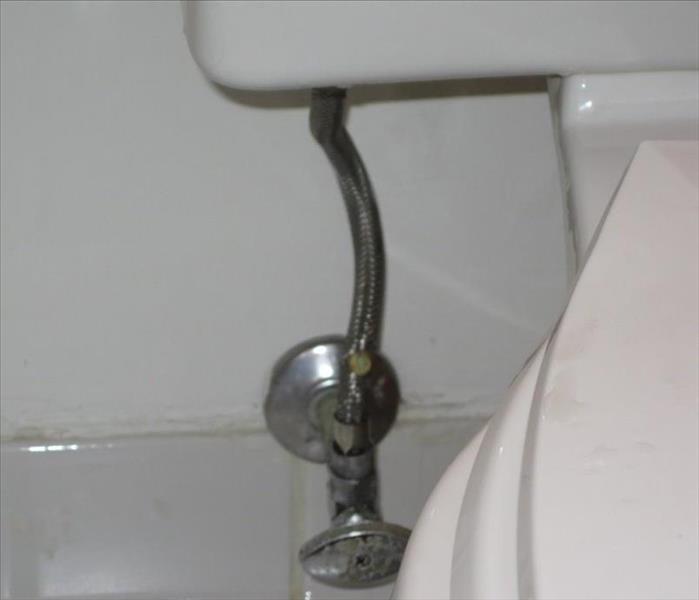 Location for water supply valve under a toilet.
Location for water supply valve under a toilet.
If you discover a water leak in your home, the first few minutes are critical. The top priority is to avoid panic and focus on getting the source of the water stopped. The most common water leaks in a home can be traced to the kitchen or a bathroom.
Most all common water supplies in a residence have a cut-off valve nearby and all valves can be turned off with a clockwise turn. If the source of the leak is your washing machine, the valves to turn off the flow are located behind the machine. Do not disconnect the hoses. Instead, turn off the water flow where the hoses are connected in the wall.
In the kitchen, you will find shut-off values for the faucet under the sink. This is also where you will most likely find the shut-off valve for an ice maker, if your freezer is equipped with one. The valve that controls your sink is usually the same valve that provides flow to your dishwasher. In a bathroom, cutoff valves are below the sink and may be within a sink cabinet if you have one. The supply line for the toilet is commonly located under and behind the seat.
A water heater can also be the source of your leak. If it is a gas tank, turn off the gas supply first then turn off the water. The water supply valve is usually located near or above the top of the tank.
Stopping the leak at its source as quickly as possible will minimize damage to cabinets, floors, walls and contents. Within a single minute, several gallons of water can flow into your home and saturate anything in its path, including adjacent rooms.
Some leaks cannot be stopped with an inside valve so the water supply to your house has to be interrupted. Lines carrying water into your home come from a main line outside that can usually be found close to the street where your water meter is located.
At SERVPRO® of Gwinnett County South, we are experts at mitigating water damages. Our emergency services include extraction, removal of damaged debris, getting your home dry and providing you with the information and services you need to make water damage “Like it never even happened.” Call us at (770) 448-5782
 SERVPRO of Gwinnett County South can help at the drop of a hat when you experience any water emergency.
SERVPRO of Gwinnett County South can help at the drop of a hat when you experience any water emergency.


 24/7 Emergency Service
24/7 Emergency Service














